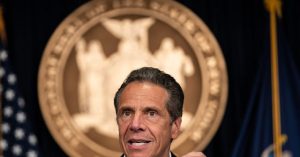An independent investigation into the COVID-19 outbreak at the Holyoke Soldiers’ Home says decisions made by leadership during the latter half of March 2020 “were utterly baffling” and that “substantial errors and failures” by the team “likely contributed” to the deaths of residents there.
The Soldier’s Home, with residents’ average age of 85 and a make up of veterans who served in World War II, and the Vietnam and Korean wars, saw 76 resident deaths during the pandemic. Another 84 residents tested positive, while 80 staff members also came down with the virus, according to the report by Attorney Mark Pearlstein, a former federal prosecutor hired by Gov. Charlie Baker to investigate the deadly outbreak at the home. The long-awaited report was released Wednesday morning. The home’s death toll is the highest known of all long-term care facilities in the country.
Since the outbreak, the home’s superintendent Bennett Walsh, was placed on administrative leave on March 30. He said back in late May that he notified the state Department of Veterans’ Service and Executive Office of Health and Human Services on March 21. Baker’s office has said it hadn’t heard of the outbreak until March 28 when authorities were notified by Holyoke Mayor Alex Morse.
Prior to the report’s release, the state’s secretary of veterans services, Francisco Urena, announced his resignation on Tuesday.
“I’m very sorry,” Urena told WCVB-TV, according to the Associated Press. “I tried my best.”
Families of residents at the home became frustrated – Susan Kenney, whose father Charlie Lowell lived there and died during the outbreak, couldn’t reach anyone at the home about her father’s condition, she told the Associated Press.
“Somebody screwed up there,” Kenney said, according to the news service in April.
Here’s some of the key findings from the report:
- The “most substantial error” was the Home’s leadership’s decision to move all residents from one of its two dementia units, which are locked, to the other, effectively crowding everyone in with people that resided there prior. Both of the units had a mix of people who had COVID-19 symptoms, had tested positive, and some that didn’t have symptoms at all, the report says. “Rather than isolating those with the disease from those who were asymptomatic—a basic tenet of infection control—the consolidation of these two units resulted in more than 40 veterans crowded into a space designed to hold 25. This overcrowding was the opposite of infection control; instead, it put those who were asymptomatic at even greater risk of contracting COVID-19,” according to the report. When a social worker tried to speak up about the risk of spreading the virus, the Home’s Chief Nursing Officer said, “it didn’t matter because [the veterans] were all exposed anyway and there was not enough staff to cover both units.”
- Leadership claimed they didn’t have enough staff for both units and “had no choice but to combine these units,” according to the report. “They are incorrect. Within hours of arriving on March 30, 2020, the Commonwealth’s emergency response team assessed the acuity of the patients and quickly sent many of them to hospitals and other acute-care facilities. The same option was available to Mr. Walsh and his team.”
- Workers described the horrors within as “total pandemonium” and “we [were] moving these unknowing veterans off to die.” The report notes, “An experienced healthcare administrator sent in three days later to address the crisis described the unit as resembling ‘a war zone,’ with some veterans clothed, some unclothed, and some obviously in the process of dying from COVID-19.”
- A social worker told investigators of sitting with one veteran, holding his hand, while across from them another veteran is “actively dying and moaning.” There’s no curtain or any form of barrier between them. Still, there’s a third veteran, who is talking about lunch. “He is alert and oriented, pleasantly confused, and talking about the Swedish meatballs at lunch and comparing them with the ones his wife used to make,” the social worker is quoted as saying in the report. “I am trying to not have him concentrate on the veteran across from him who is actively dying, or the one next to him who I am holding his hand while he is dying.
- While investigators say the outbreak doesn’t mean failure by Walsh and the rest of the home’s administrative staff, the leadership’s shortfalls “likely contributed” to the amount of deaths. “… Our analysis of the Home’s preparations for and response to COVID-19 in light of existing public health recommendations has identified substantial errors and failures by the Home’s leadership that likely contributed to the death toll during the outbreak. Indeed, some of the critical decisions made by Mr. Walsh and his leadership team during the final two weeks of March 2020 were utterly baffling from an infection control perspective, and were inconsistent with the Home’s mission to treat its veterans with honor and dignity,” according to the report.
- The report criticizes the state Department of Veterans’ Services for placing Walsh in the position in the first place, and the state’s oversight. “While the Home’s leadership team bears principal responsibility for the events described in this report, Mr. Walsh was not qualified to manage a long-term care facility, and his shortcomings were well known to the Department of Veterans’ Services—yet the agency failed to effectively oversee the Home during his tenure despite a statutory responsibility to do so.
- The Home’s leadership appeared to shift gears from stopping the spread of the virus in the locked dementia units to “preparing for the deaths of scores of residents,” the report says. “Social workers were assigned to contact family members to discuss end-of-life preferences. On the afternoon of the consolidation, 13 additional body bags were delivered to the 1-North unit. A refrigerated truck, intended to supplement the limited capacity of the Home’s morgue, arrived on Saturday, March 28,” the report says.
- Home leadership “substantially complied” with reporting to state officials, even if Walsh “at times conveyed inaccurate or incomplete information about the Home’s response efforts,” the report says. Requirements at the time called for reports of deaths of those who tested positive, and the amount of positive tests, not the amount who were suspected of having COVID-19 but for whom officials didn’t yet have a positive test in hand. This made for “confusion on March 29” when Holyoke Mayor Alex Morse claimed there were eight residents who had died the past weekend, and Health and Human Services Secretary Marylou Sudders said he was wrong and there had only been two deaths. “ Mayor Morse was, in fact, correct: the information on which Secretary Sudders relied had been accurately reported by the Home as of that morning, but did not reflect other veterans who had passed after the Home’s daily report had been submitted, or those for whom COVID-19 test results were still pending. That evening, once the correct death toll was confirmed, Secretary Sudders organized a response team to arrive the next morning and take command of the Home,” the report says.
Read the full report.
!['We [were] moving these unknowing veterans off to die': Read
the report on the COVID-19 outbreak within Holyoke Soldiers'
Home 1 'We [were] moving these unknowing veterans off to die': Read
the report on the COVID-19 outbreak within Holyoke Soldiers'
Home 1](https://globalpandemic.net/wp-content/uploads/2020/06/https___arcmigration-prdweb.bostonglobe.com_r_Boston_2011-2020_2020_03_31_BostonGlobe.com_ReceivedContent_Images_RinaldiHolyoke15-850x478-1.jpg)


















